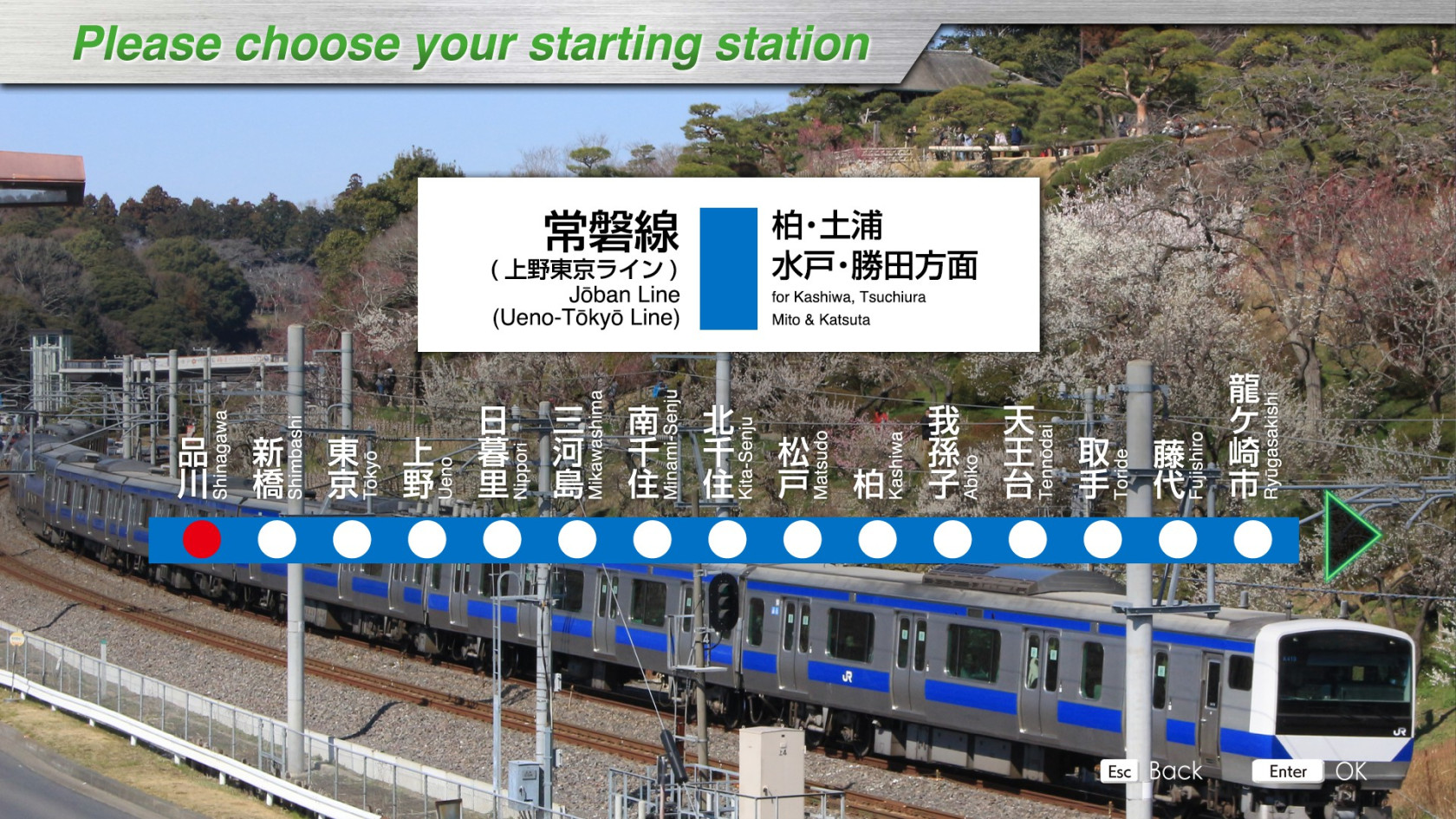Joban Line
Introducing
The Joban Line runs from Ueno Station in Taito-ku, Tokyo, to Sendai Station in Sendai City, Miyagi Prefecture, via Chiba, Ibaraki, and Fukushima prefectures, and is the longest line among JR lines not named "Main Line. Until now, the Joban Line has operated to and from Ueno Station, but on March 14, 2015, the Ueno Tokyo Line began service, with some trains now running between Shinagawa and Ueno.
This DLC includes the Ueno Tokyo Line between Shinagawa Station and Ueno Station and the Joban Line between Ueno Station and Katsuta Station.
The line is characterized by the change of electrification system along the way, and there is a DC/AC switchover (dead section) between Toride and Fujishiro stations. (Shinagawa Station to Toride Station: 1500V DC, Fujishiro Station to Sendai Station: 20,000V AC)
Another major feature of this line is that it can operate at 130 km/h, the highest speed on a conventional JR line.
The first half of the line shows a significant change in scenery along the line from an office area in central Tokyo to a bed town. The second half of the line features the peaceful green landscape of Ibaraki Prefecture.
The long-distance route, which takes about two hours, allows passengers to enjoy driving while viewing the changing scenery along the route.
Key data
- Line Length: 133.7 km
- Number of stations: 29
- Safety system: ATS-P
- Train model: E531-0 series (10 cars)
- Max speed:
- Shinagawa ~ Nippori : 110 km/h
Nippori ~ Katsuta : 130 km/h (limite avec 🟩 : +10 km/h).
- Shinagawa ~ Nippori : 110 km/h
- Routes:
- Shinagawa ~ Katsuta (1177M) : Local train - 29 stations - 133.7 km
- Shinagawa ~ Tsuchiura (1157M) : Special Rapid train - 18 stations - 63.8 km
- Automatic announcements: No
- Conductor announcements: Yes
- Driver announcement (pointing-and-calling): No
Features
This line contains 6 dead sections, the first of which, between Toride and Fujishiro, involves a change of current (DC -> AC). Note that a voice warning is issued, as well as a flashing indicator at the top right of the right-hand screen, depending on the type of zone:
- DC -> AC changeover zone: "Mamonaku kōchoku section / 間もなく交直セクション" alert and "交直切換" indicator.
- Single neutral zone: "Mamonaku komogomo section / 間もなく交交セクション" alert and "交交" indicator.
Stations list
| Station name |
Japanese name |
Distance from Nippori (km) |
Local |
Special Rapid |
JRETS connections |
|---|---|---|---|---|---|
| Shinagawa |
品川 | 12,6 |
● | ● |
JY Yamanote |
| Shimbashi | 新橋 | 7,7 |
● | ● |
JY Yamanote |
| Tokyo |
東京 | 5,8 |
● | ● |
JY Yamanote JC Chūō (last stop) JO Sōbu (Rapid) JU Utsunomiya (last stop) JT Tokaido JE Keiyō (last stop) Tokaido Freight (last stop) |
| Ueno |
上野 | 2,2 |
● | ● |
JY Yamanote JU Utsunomiya JU Takasaki |
| Nippori | 日暮里 | 0 | ● | ● |
JY Yamanote |
| Mikawashima | 三河島 | 1,2 | ● | | | |
| Minami-Senju | 南千住 | 3,4 | ● | | | |
| Kita-Senju | 北千住 | 5,2 | ● | ● | |
| Matsudo | 松戸 | 15,7 | ● | ● | |
| Kashiwa | 柏 | 26,9 | ● | ● | |
| Abiko | 我孫子 | 31,3 | ● | | | |
| Tennōdai | 天王台 | 34,0 | ● | | |
|
| Toride | 取手 | 37,4 | ● | ● | |
| Fujishiro | 藤代 | 43,4 | ● | ● | |
| Ryūgasakishi | 龍ケ崎市 | 45,5 | ● | ● | |
| Ushiku | 牛久 | 50,6 | ● | ● | |
| Hitachino-Ushiku | ひたち野うしく | 54,5 | ● | ● | |
| Arakawaoki | 荒川沖 | 57,2 | ● | ● | |
| Tsuchiura | 土浦 | 63,8 | ● | ● | |
| Kandatsu | 神立 | 69,9 | ● | ||
| Takahama | 高浜 | 76,4 | ● | ||
| Ishioka | 石岡 | 80,0 | ● | ||
| Hatori | 羽鳥 | 86,5 | ● | ||
| Iwama | 岩間 | 91,9 | ● | ||
| Tomobe | 友部 | 98,8 | ● | ||
| Uchihara | 内原 | 103,5 | ● | ||
| Akatsuka | 赤塚 | 109,3 | ● | ||
| Kairakuen | 偕楽園 | 113,4 | ● | ||
| Mito | 水戸 | 115,3 | ● | ||
| Katsuta | 勝田 | 121,1 | ● |
Movie
Useful links
Wikipedia : https://en.wikipedia.org/wiki/J%C5%8Dban_Line
Driver's guide and timetables: https://docs.google.com/spreadsheets/d/1bmmf3sH66l5TGKOQmtigAochaUtXWKdScnRs0oIa6y8/edit#gid=422915208

